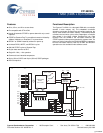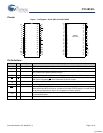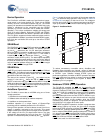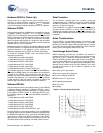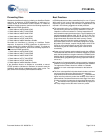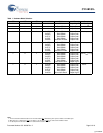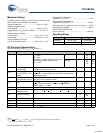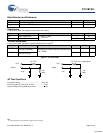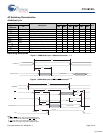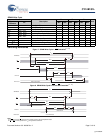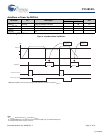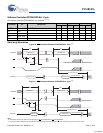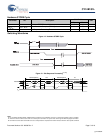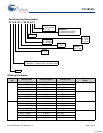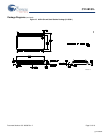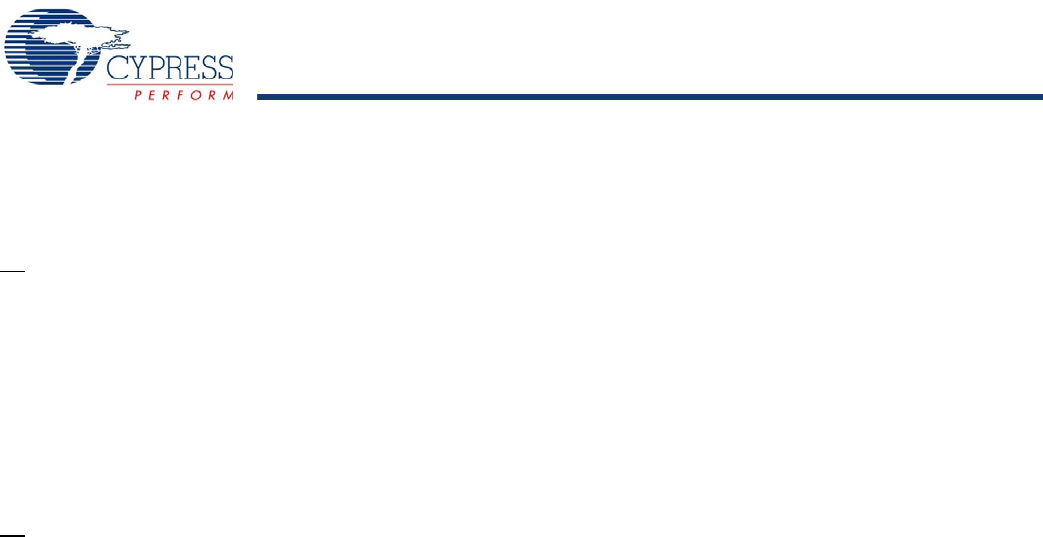
CY14B101L
Document Number: 001-06400 Rev. *I Page 5 of 18
Preventing Store
Disable the AutoStore function by initiating an AutoStore Disable
sequence. A sequence of READ operations is performed in a
manner similar to the software STORE initiation. To initiate the
AutoStore Disable sequence, perform the following sequence of
CE
controlled READ operations:
1. Read Address 0x4E38 Valid READ
2. Read Address 0xB1C7 Valid READ
3. Read Address 0x83E0 Valid READ
4. Read Address 0x7C1F Valid READ
5. Read Address 0x703F Valid READ
6. Read Address 0x8B45 AutoStore Disable
Re-enable the AutoStore by initiating an AutoStore Enable
sequence. A sequence of READ operations is performed in a
manner similar to the software RECALL initiation. To initiate the
AutoStore Enable sequence, perform the following sequence of
CE
controlled READ operations:
1. Read Address 0x4E38 Valid READ
2. Read Address 0xB1C7 Valid READ
3. Read Address 0x83E0 Valid READ
4. Read Address 0x7C1F Valid READ
5. Read Address 0x703F Valid READ
6. Read Address 0x4B46 AutoStore Enable
If the AutoStore function is disabled or re-enabled, a manual
STORE operation (Hardware or Software) is issued to save the
AutoStore state through subsequent power down cycles. The
part comes from the factory with AutoStore enabled.
Best Practices
nvSRAM products have been used effectively for over 15 years.
While ease of use is one of the product’s main system values,
experience gained working with hundreds of applications has
resulted in the following suggestions as best practices:
■
The nonvolatile cells in an nvSRAM are programmed on the
test floor during final test and quality assurance. Incoming
inspection routines at customer or contract manufacturer’s
sites sometimes reprogram these values. Final NV patterns are
typically repeating patterns of AA, 55, 00, FF, A5, or 5A. End
product’s firmware should not assume an NV array is in a set
programmed state. Routines that check memory content
values to determine first time system configuration, cold or
warm boot status, and so on must always program a unique
NV pattern (for example, complex 4-byte pattern of 46 E6 49
53 hex or more random bytes) as part of the final system
manufacturing test to ensure these system routines work
consistently.
■
Power up boot firmware routines should rewrite the nvSRAM
into the desired state. While the nvSRAM is shipped in a preset
state, the best practice is to again rewrite the nvSRAM into the
desired state as a safeguard against events that might flip the
bit inadvertently (program bugs, incoming inspection routines,
and so on).
■
If autostore is firmware disabled, it does not reset to “autostore
enabled” on every power down event captured by the nvSRAM.
The application firmware should re-enable or re-disable
autostore on each reset sequence based on the behavior
desired.
■
The V
CAP
value specified in this data sheet includes a minimum
and a maximum value size. Best practice is to meet this
requirement and not exceed the maximum V
CAP
value because
higher inrush currents may reduce the reliability of the internal
pass transistor. Customers that want to use a larger V
CAP
value
to make sure there is extra store charge should discuss their
V
CAP
size selection with Cypress to understand any impact on
the Vcap voltage level at the end of a t
RECALL
period.
[+] Feedback



